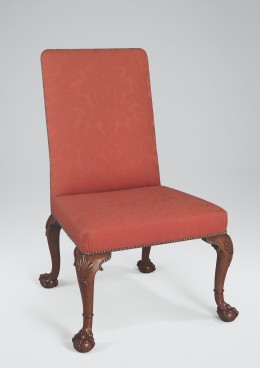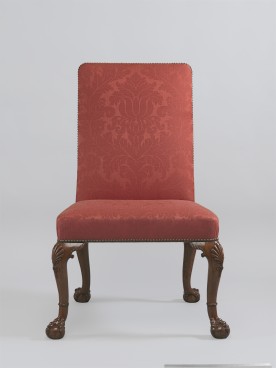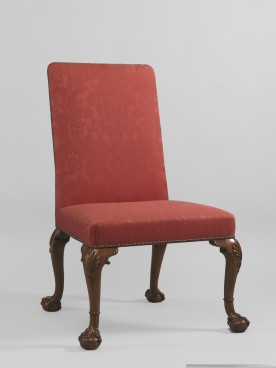Chair, c.1735
Walnut, now with late 20thcentury wool damask
This chair is one of a pair from a set of eighteen supplied in 1735 by William Hallett (1707–1781) for the London house of Arthur Ingram (1689–1736), 6th Viscount of Irvine, of Temple Newsam, leeds.
Adam Bowett Catalogue (19/08/2012)
Description
A pair of upholstered chairs, 1735. The rectangular backs and trapezoid seats are covered with close-nailed red woollen damask and raised on cabriole legs with shell carved knees, gaiters and claw feet, with matching back legs.
Dimensions
H: 40” (102cm) Seat height: 19” (48cm) W: 26 ½ ” (67cm) D: 26 ¾ “ (68cm)
Designer/Maker
William Hallett
Materials
Walnut, beech
Dating Criteria
These chairs were supplied by William Hallet for the London house of Lord Irwin. Hallet’s bill is dated 9 August 1735.
Construction
Construction of the back is conjectural because enclosed by needlework. All four legs are solid walnut, with solid walnut brackets and supported behind by shaped beech blocks formed in one piece with the seat rails. The beech seat rails are tenoned into the tops of the legs. There are diagonal struts across the front corners housed into the front and side rails.
Marks or Stamps
None
Condition
16.1 – Condition of back frame is speculative because enclosed by upholstery. All four legs are heavily cleaned but sound, except for left back which has a significant repaired break. All brackets probably original apart from left front; there is worm damage to all four rails and spliced repairs to both side and rear rail.
16.2 – All four legs sound except for repairs to inside top of back right. Historic worm infestation throughout. No obvious breaks or repairs to rails.
Additional Remarks
This pair of chairs comes from a large set of eighteen, plus two settees, supplied by William Hallet for Lord Irwin’s house in GROSVENOR SQUARE in 1735. They were moved to Irwin’s principal seat, Temple Newsam House, near Leeds, in 1736. The chair frames cost 23 shillings each, the settees £2. 9s. each. The upholsterer’s bill also survives. Lord Irwin supplied the red silk damask for the top covers but the bill was nevertheless substantial, amounting to £23. 5s. 4d for the 18 chairs and settees. Loose serge covers cost a further £11. 12s. 0d.
The original covers were red silk damask fitted over a red linen base cover. The trim was cord bound with red silk lace, and the stuffing horsehair. The backs of the chairs were fitted with red silk ‘scarves’; these were squares of silk which hung down the back of the chair when not in use, and when in use were flipped over the chair back to prevent wig powder and grease from spoiling the silk damask – a sort of 18th century antimacassar. A pair of chairs from the same set, now returned to Temple Newsam House, have been recovered and fitted with scarves to demonstrate the principle.
William Hallet (c.1707-81) was one of the most prominent London furniture-makers of the time, although little documented furniture survives. His premises were in Long Acre, in the heart of the fashionable West End furniture-making district. The Irwin chairs are, however, utterly conventional in design, employing the shell knee and claw foot which was virtually ubiquitous at this date.
References
Connoisseur (December 1964), pp.224-225.
Gilbert, ‘The Temple Newsam Furniture Bills’, Furniture History, III (1967), pp. 16-28.
For William Hallet, see Geoffrey Beard and Christopher Gilbert (eds.), Dictionary of English Furniture Makers, 1660-1840, Leeds (1986), pp. 387-389.
Provenance
Bills and invoices for chair and upholstery in Temple Newsam archives. Made for 6th viscount Irwin, transferred to Temple Newsam on his death. Sold by Robinson, Fisher and Harding 26-31 July 1922 in sale of content of temple Newsam, bought by Frank partridge.
Bought from Partridge by Hall family, Shropshire, Sold by Patrick Hall.
Purchased Gurr-Johns 8th March 1999








